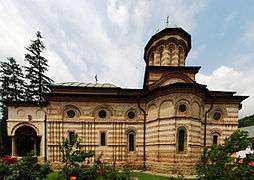Cozia Monastery
Cozia Monastery, erected close to Călimănești by Mircea the Elder in 1388 and housing his tomb, is one of the most valuable monuments of national medieval art and architecture in Romania.
| Cozia Monastery | |
|---|---|
Mănăstirea Cozia | |
 Holy Trinity Church of the Cozia Monastery | |
| Religion | |
| Affiliation | Eastern Orthodox |
| Ecclesiastical or organizational status | Monastery |
| Leadership | Archbishop Varsanufie of Râmnic and Argeș |
| Patron | Holy Trinity |
| Year consecrated | 1388 |
| Status | Active |
| Location | |
| Location | Călimănești, Vâlcea County, Romania |
| Geographic coordinates | 45.27159°N 24.31549°E |
| Architecture | |
| Founder | Mircea the Elder |
| Groundbreaking | 1387 |
| Completed | 1391 |
History
The name of the monastery is of Cuman origin and it means "walnut grove", from Turkic word koz, meaning walnut.[1] The original name of the place was the Romanian equivalent, Nucetul, but already in 1387, a document of Mircea cel Bătrân uses the current name.[1]
The fortified cloister dates from the foundation (1388) and is the only in Byzantine style preserved in Romania. Two chapels are incorporated in the side toward the Olt River and their Byzantine cupolas are reflected in the water, creating one of the most iconic cultural - natural landmarks in Romania.
The appearance of the church was modified under Neagoe Basarab (1517), Şerban Cantacuzino and Constantin Brâncoveanu (1707), who added a veranda, a new fountain, a chapel and a watch tower, adding to its architecture the 'brâncovenesc style'.
The wall facets' decorations with stone rosettes, horizontal Byzantine-style rows of brick and stone and vertical frames are unprecedented in Wallachian architecture. The resemblance with Lazarica church indicates that Mircea cel Bătrân has employed Serbian craftsmen from the Morava School.
Of great value is the hospital church, 'bolnița' (1543), with original well-preserved indoor frescoes like the votive portrait of ruler Mircea cel Bătrân and his sons.
Cozia was painted between 1390 and 1391. Some of the original frescoes (1390) are still well preserved.
The church of the monastery was put on a Romanian stamp in 1968.
Museum
Cozia features a museum of exhibiting old art: old manuscripts and prints, embroideries and objects of worship.


References
- Iordan, Iorgu (1963). Toponimia romînească. Bucharest: Editura Academiei Republicii Populare Romîne. p. 84. OCLC 460710897.
External links
| Wikimedia Commons has media related to Cozia Monastery. |
- The Cozia Monastery, official site, but currently (3 sept 2015) hacked by some malware system.
- (in Romanian) Mănăstirea Cozia, at Episcopia Râmnicului
- Virtual Tour of Cozia Monastery